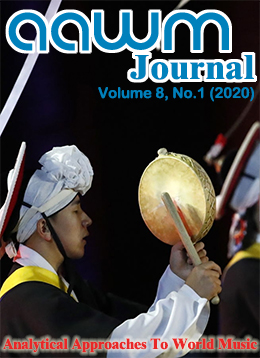 |
|
 |
 |
 |
 |
 |
|
AAWM JOURNAL Volume 8, No. 1 (2020) |
 |
 |
| Volume 8, No. 1 (2020) |
|
 |
 |
| “Release Hitting”: An Analytical Study Commemorating the Artistry of the South Korean Shaman Musician Kim Yongt’aek |
| Simon Mills (Durham University) |
|
Within the world of South Korean traditional music, the percussion-based ritual music performed by hereditary shaman troupes in the East Coast region is justly famed for the diversity and complexity of its rhythmic structures and the virtuosic patterning that the ritualists often produce. This article presents a detailed rhythmic analysis of a multi-sectional structure called “tchoshigae,” which is frequently reckoned by the ritualists to be the most difficult item to perform in their repertoire, primarily because of its passages of ever-shifting polyrhythmic interplay, its lengthy metrical frameworks characterized by irregular and flexible internal organization, and its rapid tempi. In addition, because tchoshigae is performed at a critical juncture in a post-death ritual (Ogu Kut), the ritualists are keenly aware its effective performance is crucial to ensuring a successful ritual.
Specifically, this analysis focuses on a single ritual performance of tchoshigae recorded by the author in April 2000, led by the celebrated ritual musician Kim Yongt’aek, playing the changgo drum, and his wife the shaman Kim Yŏngsuk, singing of the challenges posed by death, with other essential parts provided on kkwaenggwari hand-gongs and ching gong. The aim here is to present a thorough and wide-reaching examination of the selected performance, elucidating the music’s metrical frameworks, identifying how the ritualists organize their patterning within those frameworks, and clarifying the links between musical attributes, song text, belief system, and ritual objectives. Kim Yongt’aek, who passed away in February 2018, was the most highly esteemed and widely emulated instrumentalist within the tradition; this analysis shines a light on the impressive musical artistry that he cultivated together with Kim Yŏngsuk....more >>
|
|
 |
 |
| Theorizing Trikāla: A Generalized Intervallic Approach to Pulse Transformation in South Indian Carnatic Music |
| Robert Wells (University of Mary Washington) |
|
The rich rhythmic/metric construction of South Indian Carnatic music is characterized, in large part, by intricate interplay between an internalized metric cycle called the tāḷa and performed phrases that may generate expressive tension with this tāḷa. Thus, informed listeners, who track the tāḷa using standardized hand gestures (kriyās), may experience substantial internal tension. A common source of such tension is trikāla technique, in which the performed pulse unit expands or contracts over constant tāḷa. While trikāla has been thoroughly described performatively, historically, and culturally, it has received little attention within the music-theoretic realm. Thus, this paper seeks to approach trikāla technique from the perspective of Lewin’s (1987) transformation theory, applying the metric generalized interval system (GIS) Met developed by Wells (2015a; 2015b; 2017) to the problem of representing and quantifying this technique.
The first part of this article lays the theoretical foundation for Met-based analysis of Carnatic music, demonstrating basic techniques for representing Carnatic rhythmic/metric structures using the GIS. Of these techniques, the most significant for the current study are intervallic expansion and contraction transformations. Because these transformations are generated by expanding or contracting pulse units over a constant background meter, they are ideally suited for modeling Carnatic trikāla technique. The next two sections apply these theoretical ideas to analyses of traditional pedagogical exercises called alankārams and a rāgam-tānam-pallavi (RTP) performance previously investigated by Widdess (1977). These Met-based analyses reveal hidden aspects of the music’s metric workings, demonstrating how seemingly simple expansions and contractions of the melodic pulse unit can drastically increase rhythmic/metric complexity. Moreover, in the alankaram exercises and the RTP performance, the intervallic developments suggest a striking balance between stability and change in the relationships between melody and tāḷa. The Met intervals also act as analytical agents, representing contextual metric functions and rhythmic/metric sources of musical development. Ultimately, the analyses not only provide new insights into trikāla technique in the specific examples in question, but suggest new possibilities for rhythmic/metric analysis of tāḷa-based Carnatic music more generally....more >>
|
|
 |
 |
| Makam and Beyond: A Unified Theory in Julien Jalâl Ed-Dine Weiss’s Last Composition |
| Stefan Pohlit |
|
The Swiss-Alsatian qānūn virtuoso Julien Jalâl Ed-Dine Weiss (1953-2015) belonged to the most prominent performers of maqām music on the world music stage. During the 1980’s, he moved to Aleppo and founded the Al-Kindi Ensemble with which he would deliver many key interpretations of the historical repertoire. An outspoken critic of Western equal-semitone temperament, he invented a tuning system in just intonation and constructed several qānūn prototypes with extended pitch supply in order to encompass the characteristics of various regional contexts.
Despite Weiss’s international fame, the future of his legacy remains uncertain: Due to the Syrian war, most of his estate has been destroyed while his hand-written notations have never been catalogued. My analysis explores his last composition, Spiritual Journey/Sinfonia Sacra, a suite of more than twenty minutes and the most time-consuming project of his career. It was premiered in 2011 at the Beiteddine Festival in Lebanon and completed until Weiss’s death, partly with my assistance. As a curious amalgamation of influences from the Ottoman repertoire, Iran, and India, the score expands the maqām principle towards a novel concept of prolongation, symmetry, and implied polyphony.
Although Weiss’s qānūn was built to reproduce many different customs of traditional tuning, most of the score’s material originates from the Turkish-commatic system and could thus easily be adopted by the specifially Turkish line-up of the Al-Kindi Ensemble after his move to Istanbul. Comparable to his famous teacher, Munir Bashir, Weiss both respected and redeveloped the tradition. Some of his decisions, such as a number of unusual combinations of modal genres, may appear rather experimental in regard to the Ottoman repertoire to which he referred. However, besides offering a unique insight into his concept of seyir (i.e., the outline of a makam with all its related modulations), Spiritual Journey introduces a highly original method of organization by means of small, permutable cells. By tying pitch relationships and metric symmetry together as intrinsic unity, Weiss created an extensive, cohesive structure within a continuum of large rhythmic cycles—an architecture of foreground-background relationships unprecedented in makam music.
My analysis includes the entire score which is published for the first time for further scrutiny....more >>
|
|
 |
 |
| Transformations of Tonality: A Longitudinal Study of Yodeling in the Muotatal Valley, Central Switzerland |
| Yannick Wey |
|
This paper examines the transformation of tonalities in the Central Switzerland village of Muotatal, a small region attracting the focus of ethnomusicologists for harboring and conserving a unique style of yodel, called juuz. The longitudinal study compares three samples of field recordings, collected by Sichardt (sample 1, 1936), Zemp (sample 2, 1979) and Wey (sample 3, 2017). Pitch data are retrieved for the three samples, each consisting of 8 to 10 pieces of solo yodel and over 600 single intervals. As the melodies are organized in horizontal rather than vertical relations, the distribution of pitch is analyzed based on neighboring intervals. The three samples are compared in order to observe transformations the tonal systems have undergone during the time intervals of about 40 years each. The key findings demonstrate a shift of tonality toward equal temperament over the periods observed. While characteristic neutral intervals (seconds, thirds, sixths, sevenths) prevail in the first sample, they are replaced by just and equal-tempered intervals in samples 2 and 3. The findings support the hypothesis that the institutionalization of music pedagogy and four-part choir singing prompted the demise of traditional tonal aesthetics in Alpine valleys....more >>
|
|
|
 |
|
 |
 |
|



